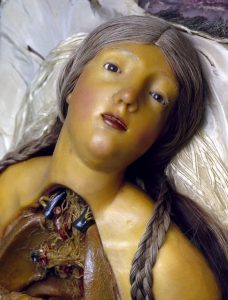 Noam Toran is a designer who makes film. Or is he a film maker teaching at design schools?
Noam Toran is a designer who makes film. Or is he a film maker teaching at design schools?
He was born in Las Cruces, New Mexico and moved to London from the States seven years ago. His work uses products and film to investigate anomalies in human behaviour; anomalies which specifically reflect a retaliation against imposed social conformity. In almost all of his work there is a darkly humorous conflict: What types of identity do we project onto objects? What does this reveal about the human condition and the systems that organize society?
I first got to know about him by reading something about his Objects for Lonely Men, eight products designed to alleviate loneliness after a girlfriend has left you. The project is an attempt to understand what initiates loneliness; do we miss the individual or the generic traces they leave behind? The collection includes a Sheet Stealer that winds the bedclothes up on the other side of the bed while you’re sleeping. Another joy of sharing a bed is re-created with a pair of cold feet like objects to install under the blanket. In the morning, the steel finger of the Chest Hair Curler can rotate gently and play with your chest hair, while Shared Cigarette comes into its own after a solitary sex act: it has two holes, one for the cigarette, and the other that exhales smoke.
Last Autumn i finally saw some of his work at the D.DAY, le design aujourd’hui exhibition hosted by the Centre Pompidou in Paris. There were two short films. A very fascinating Object For Lonely Men that tells the story of a man so obsessed with Jean-Luc Godard‘s A Bout de Souffle (Breathless) that he builds a tray which reflects the physical language of the film. The tray contains a series of objects that the man interacts with. The objects include a mannequin head which resembles Jean Seberg (the female lead), a gun, a hat similat to the one Jean-Paul Belmondo sports in the movie, telephone, Herald Tribune newspaper, sunglasses, ashtray, steering wheel, rear view mirror and a pack of Gitanes non-filtered cigarettes. The project addresses the influence of film on our identity and fantasy, and how objects often mediate these fantasies.
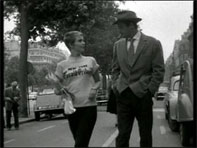
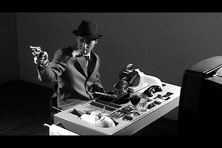
Screenshots from Breathless and Object For Lonely Men
The other movie screened in Paris was the very quiet, unconventional and humorous Desire Management that address complex, emotionally and philosophically charged needs rarely addressed by the commercial market.
There’s the Baseball Bed, a suitcase that opens to become a bed shaped like a section of a baseball field. The client is a 35 year-old Japanese man who lost his virginity on a baseball field and wishes to recreate the experience with future partners. The Turbulent Air Hostess Trolley is a trolley with built-in turbulence. The client is a former airline hostess who suffered a panic attack on a flight. She is now unable to fly, and sees the trolley as part of her ongoing therapy to regain confidence in the air. Vacuum Scanner is a body-sized pole with a vacuum cleaner. The client is an American widower who enjoyed being vacuumed by his wife, and has commissioned the object in order to be able to achieve the sensation on his own.
Noam Toran is currently teaching on the Design Products course at the RCA, and working on two film commissions this year, one from the Wellcome trust in London, one from the Luxembourg MOMA, along with writing the script for a feature length film. I interviewed him as he was just back from San Jose.


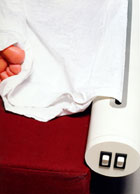 Chesthaircurler, Shared Cigarette and Sheet Stealer
Chesthaircurler, Shared Cigarette and Sheet Stealer
What inspired the Accessories for Lonely Men? Personal experience?
Yes, I had just ended a five-year relationship and was going through a dark period. Loneliness became a central point of interest, both personally and philosophically, and is a theme which I never seem to stray far away from, often trying to address it through humour.
You’ve shown your movies in art shows, design exhibitions and film festivals. Which one is the best setting for your work? Do the different audiences react differently to the same movie? For example does the design audience tend to take it more seriously than the film festival crowd who’d see it as pure fiction?
This is a good question and one which I have trouble answering, primarily because an audience’s reaction tends to be unquantifiable. I think (and hope) that an audience will see any piece of work through a lens which reflects their interests, and that within my films there is a theme, a character or an object which triggers something personal. I certainly don’t think a design audience, as fleeting a definition as that is, is more serious than a film festival crowd! With regards to which venue is best for the work, film festivals are my current favourite, as there is a quality in presentation (big screen, great sound, seated and popcorned audience) which you just can’t get elsewhere.
What it the most important component in the design and service you work on? The movie or the actual object? How do they complement each other?
The two go hand in hand, I don’t have a very consistent way of working, but I tend to come up with short stories based on reoccurring interests (loneliness, fetishism, defiance against social conformity, celluloid obsession) where an object becomes the central focus of interest (and vehicle of expression) for a fictional character. Film (more and more) is the apt medium for presenting the story, and one which I am slowly gaining confidence in.
I’m particularly fascinated by the tray in Object For Lonely Men. Can you describe it and how is could be used? Has any Godard fan ever reacted to it?
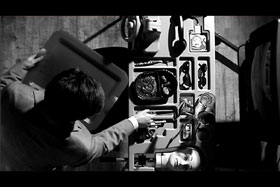 The tray houses as many physical representations of “Breathless” as can fit: Herald Tribune newspaper, Gitanes cigarettes, gun, hat, telephone, ashtray, steering wheel, and Jean Seberg’s head. In “Object for Lonely Men” the main character uses the tray to play along with Belmondo, enhancing and validating what already occurs, namely our projection onto a celluliod character. “Breathless” is itself a commentary on this projection; Belmondo’s character worships Humphrey Bogart, wants to date an American girl, drive American cars, shoot guns, essentially behave like the gangsters from classic Hollywood crime films. A lot of Godard fans are very complimentary about “Object for Lonely Men”, others (the purists!) are upset mainly with my cutting up the film and reworking it into my own, which is fair enough.
The tray houses as many physical representations of “Breathless” as can fit: Herald Tribune newspaper, Gitanes cigarettes, gun, hat, telephone, ashtray, steering wheel, and Jean Seberg’s head. In “Object for Lonely Men” the main character uses the tray to play along with Belmondo, enhancing and validating what already occurs, namely our projection onto a celluliod character. “Breathless” is itself a commentary on this projection; Belmondo’s character worships Humphrey Bogart, wants to date an American girl, drive American cars, shoot guns, essentially behave like the gangsters from classic Hollywood crime films. A lot of Godard fans are very complimentary about “Object for Lonely Men”, others (the purists!) are upset mainly with my cutting up the film and reworking it into my own, which is fair enough.
The Desire Management installation and movie addresses “neglected needs”. How do you define these needs? Do you think we’re all hiding such extreme needs? Which kind of reflection should the objects stimulate?
Neglected needs are those which are not provided for or are shunned by contemporary society, and tend to reflect a psychological complexity and a questioning of ethical parameters. Often these needs veer towards sexual and moral deviation (testing limits) but can also simply be a necessary, harmless way of defining oneself as an individual. While we have a philosophical understanding of oneself as singular, it can be difficult to define what makes us “different” to anyone else who sleeps, eats, shits and goes to work. Without going into a pretentious anarcho-communist diatribe (sometimes I cant help it!), consumer society is lulling us into a state of satiation by making us hungry for things we can easily purchase, whereas there is an essential, often dormant part of our condition which wants to misbehave in ways that aren’t sanctioned by the government. “Desire Management” presents examples, hopefully in a way that is interesting and entertaining.
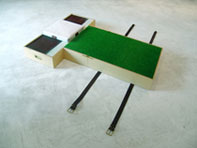
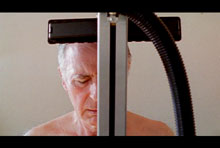
The Baseball Bed and a still from Desire Management
The objects are based on real testimonials and news reports. Once you’ve read a particularly interesting news report, how do you proceed?
Some of the objects in “Desire Management” are based on real stories either taken from news articles or from first-hand reports, while others are fictional. I tend to embellish or completely distort as I see fit, and maintain a strict measure of privacy for the people who serve as the inspiration for the work. The objects all respond to distinct personal fetishisms (taken by its broadest definition, so not simply relegated to sex with latex) or obsessions, and are designed to functionally address the protagonist’s particular need.
I read in an old article about “subliminal furniture”? Can you explain us what they are about?
Subliminal Furniture is a set of objects and short film which I developed in partnership with Tom Hulbert (now at Luckybite) and Stijn Ossevoort in 2002. The furniture has built-in, covert electronics which allowed you to transmit subliminal messages in your home, thereby eliminating the need for person-to-person conversation and turning everything into an autonomous form of manipulation. For example, a disgruntled wife might subliminally manipulate her husband into having sex with her, thus avoiding the need to seduce, to compliment, to arouse etc. A distopic satire of sorts…
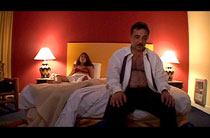
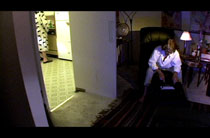
Stills from Subliminal Furniture
I read on the RCA website that you’re working on The ERCE Company and on another project called Retracement. Can you unveil something about them?
Wow, those projects are old and they should really update their site more often. I will say that I am working increasingly in film and slowly scratching my way through a feature length script about engineers who build bad things for bad people, which should keep me busy for the next two years I am also working with Onkar Singh Kular on a short film about near-death experiences for the Wellcome Trust, and another film inspired by the sci-fi writer Hugo Gernsback for an exhibition at the Luxembourg MOMA in 2007.
Any designers or artists whose work should get more attention from the public?
There’s a huge list, but off the top of my head I recommend the filmmakers Jay Rosenblatt (Human Remains) and Orville Wanzer (The Devil’s Mistress) and the photographer Kiochi Tsuzuki.
Thanks Noam!
Images courtesy of Noam Toran.



